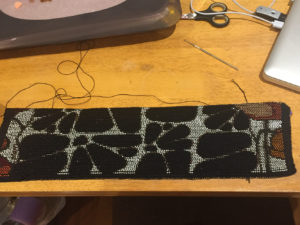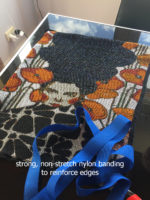My first full scale and framed beaded crochet tapestry.
 Beaded Crochet Tapestry (CH0509) – Private Collection
Beaded Crochet Tapestry (CH0509) – Private Collection
Beaded Crochet Tapestry: How To Notes
These are short notes. They remind me of the sequence and steps. Please view them as guides or pointers; not as a tutorial.
- find inspiration / artwork
- use software BeadTool4. Adjust colours and determine colours (of seedbeads) on hand. Then generate report, including a pdf report (from BeadTool4 app).
Set out your seedbeads, with the colours labelled, as per the generated pdf report.
The work will be crocheted in batches – i.e. a number of rows at a time. Here I worked between 10-20 rows at a time. It will depend on:
- how comfortable you are with working a lot of strung beads (the more the beads, the slower and harder the progress as the beads have to be continuously moved along the thread)
- how strong is the crochet thread you are using. You will be constantly moving the beads along. That could put quite a lot of strain on the thread and may cause it to fray and break.
- how wide your work is. The wider the work, the larger the number of beads per row.
IMPORTANT:
- you will be working upwards in batches. For example, if you have 100 rows, then you will string from R10-1; R20-11; R30-21 — crocheting each batch before cutting the thread and stringing the next batch.
- when working per batch of selected number of rows, you will string downwards. For example, if you are working with 2 rows, then you will string R2, then R1 (row numbering as per pdf report)
For example:
Row1: 10 black, 8 white
Row 2: 15 black, 3 white
To produce the black on one side and white on the other, you will string the beads thus:
15 black + 3 white + 10 black + 8 white - viz. when reading the Word Chart from the .pdf report, you will be stringing in one direction only – e.g. from left to right
Notes:
- (note to self mostly) to be able to crochet continuously and not have to cut and start after every row, and for the instructions above to apply, work normal sc (with beading of course) one row, and alternate with bf-sc in the next. You will be crochet beading every row.
THREAD & HOOK
Thread: 0.6mm strong nylon/polyester
Hook: 1.25mm
WIP SHOTS
Below, some WIP (work in progress) shots.
From this point in, I swam into unknown seas with fingers crossed that I would come up with ideas that would work rather than ones that would see me having to trash the work thus far … which had only taken a few months.
FIRM BANDING
I will be applying a strong, non-stretch banding along the sides. This is give it more strength and prevent future tear and sagging. This to me seems to be important as I know I will be hammering tacks along the edges of the crochet piece to install it onto a wooden frame.
The blue banding was only because that is all I had in my hoard of materials and supplies. But it doesn’t matter; no one will see this.
IMP: measure the sides of the crochet tapestry piece. Then measure out the lengths of the banding, making sure that opposite sides are of equal lengths (viz. a true rectangle). Mark out the lengths on the banding.
Carefully pin the banding to the back, easing the crochet fabric to fit the marked lengths on the banding.
Hand sew both the outer and the inner edges of the banding to the crochet fabric.
There will still be some unevenness to the crochet fabric. That is part and parcel of the nature of crochet tapestry fabric. I hope to ease off this unevenness when I install the work to a solid frame (crossing fingers tightly at this stage).
FRAME/BACKING
The next step is what to use for the frame. Believe me, I spent many many nights running through possibilities – from the formal and expensive to the cheap and ad-hoc options.
I wanted the frame to be:
- strong enough that it will hold and help stretch the crochet tapestry into shape
- not too heavy. We hate hammering big hooks and stuff into our walls.
- not so weak or light or warpy that it will not last through the years
- not so expensive that I will cry and not complete the project
So while wandering around like a lost lamb but with big, seeking eyes, I eventually came across this plank that had been lying around somewhere in our garden for years. It was amazing that it was in good enough shape for what I wanted. And even more amazingly, it was clean of critters and bugs. (shudder)
On the plank, I drew an outline of the rectangular size of the crochet tapestry plus some spacing all round.
THE MAN TO THE RESCUE
Next I needed some brawn. Plus I am a sook when it comes to bigger eletrical tools.
Out came our new saw horses. Yes, my man thought I was an idiot buying them a few years ago. But hey, lookee!! A few years on and how handy they were!!
So lucky to have The Man help me with this. The plank was roughly sanded down prior to cutting. This is prevent snags to the crochet tapestry later during installation and will also aid me when I paint the wood later.
Once the wooden backing (as it is not really a frame is it?) has been cut to size, I roughly sanded down the sides. If you look carefully, you will note that I have pencilled around the plank. So I know where the border is and where the crochet tapestry will fill.
I only painted the border. And edges. Used chalkboard black paint. Why? Coz I had some.
2-3 layers, drying inbetween coats.
KEEP FINGERS CROSSED
Now comes the ad-hoc, I-hope-it-works installation.
Lay out the tapestry, assemble tools and supplies.
Keep fingers crossed.
GLUE
I intend to glue the back of the crochet tapestry to the wooden backing. For 2 main reasons:
- the beaded crochet tapestry is pretty heavy. With approximately 35, 000 glass beads, that is not surprising. And so I hope that the glue backing will prevent the piece from sagging over time from the weight.
- as mentioned above, there are some inevitable unevenness in the crochet tapestry. I hope that with the glue on the back, I will be able to ease the fabric flat during installation.
Before applying the glue, hammer in the top row of tacks. This will secure the piece down and pull the top into shape and will act as anchor as I stretch and affix the rest of the piece.
You may also have noticed that the tacks on the 2 top corners are different from the rest. I was attempting to raise the tacks a bit as the leg (?)/shank (?) of the tacks were just a tat longer than the depth of the wooden plank. So that when I hammered a tack through, a little bit of the end point of the tack poked through on the other side.
So I thought of raising the head of the tacks and that would prevent the pointy end from poking through.
I used some spare snap-on button hardware. And it did work. The pointed ends didn’t poke through.
 However it was harder than expected. It was very fiddly. But worse, the wood proved harder than expected. Many of the tacks just bent when I hammered them in.
However it was harder than expected. It was very fiddly. But worse, the wood proved harder than expected. Many of the tacks just bent when I hammered them in.
However by the time I decided to abandon this “brilliant idea”, I had already hammered in the top 2 corners. And that is why I ended up using this “brilliant idea” only on the 4 corners.
But let us carry on.
I have now tacked down the top of the beaded crochet tapestry to the wooden backing.
Next: to glue it down.
Apply the glue but not onto the border. I used Helmar Gemstone Glue. I know – not exactly the most obvious choice. But I am determined to recycle as much as possible and not keep buying new supplies. So I still have a lot of this glue (from my online-business days). Again, I had to hope and pray it would work. And thankfully, it worked. Rather beautifully I must say.
As I pasted the crochet tapestry down, I eased off any bumps or unevenness in the fabric till it was all laying down flat.
Next, to tack down all the edges …
… and some very important tricks to ease the toil of hammering them in.
HAMMER HAMMER
TIPS
- because the wood was so hard (though thankfully not so heavy), I used the Dremel to drill the holes where the tacks were to go. The holes must be smaller than the shank of the tacks otherwise there will be no grip.
The spacing between tacks were approximate but still estimated carefully. Remember to match the holes placement so that they line up with the holes on the opposite side. - Vaseline! Who would have thought?!!! It absolutely made such a huge difference even though I initially resisted having to get up and find the Vaseline. But just applying some Vaseline to the tack shanks and then hammering them in – it was 10 times easier than without the Vaseline!!!
Once all the tacks are hammered in, the front looks pretty good.
BACK
IRL, when you look at the back at this stage, it is hard to tell that there is a problem. But as I mentioned before, the shank of the tack is too long and the tip pokes through on the back. One can feel it more than see it. Either way, it is not good. So I had to put the tired brain into finding more ad hoc solutions … (without buying new stuff!!!)
APPLYING PADDING
I really wanted a simple solution. No extra fiddly contraption to deal with those pesky, pointy tack ends sticking through.
Rummaging through my often laughed-at horde of this and that, I found 2 fat rolls of sticky felt tape!!! They were from Reverse Garbage, Sydney or another similar organisation in Melbourne. I knew all my collection of weird stuff would come in handy some day. It might take a few years and I might have to endure much sneering and laughter from friends for “collecting junk” … but hey, I love them!!
I applied the felt sticky tapes onto the back. They are adequately thick. That immediately and effectively covered up the poky ends of the tack and also provided protection for our walls when we hung this tapestry up.
HOW TO HANG IT UP?
The next question I faced was how was I going to hang this beaded crochet tapestry up? It is heavy but really not that heavy. It is just under 3kg, including the wooden backing.
That means I didn’t need to invest in picture wire nor do I have to get heavy duty picture hanging hardware.
Using my recently acquired (yes, unfortunately I still fall into temptations) staple gun, I installed 2 U-shape staples per side. The staple should be about 1/3 from the top. And instead of hanging wire, I used a doubled over, very strong cord.
A label of the specifics of the work is attached to the back. I Mod Podged over the label for protection of the paper over time.
Last but not least, a big thank you to Hülya Özdemir (her FaceBook page) for her beautiful illustration. This artwork is based on her beautiful illustration.














































